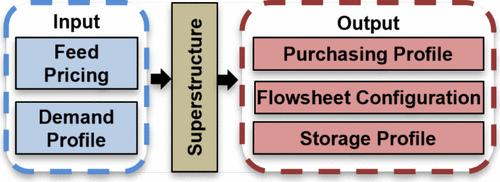Optimal Process Synthesis of Pesticide Production Considering Variable Demands and Raw Material Prices
IF 3.9
3区 工程技术
Q2 ENGINEERING, CHEMICAL
引用次数: 0
Abstract
In pesticide manufacturing, the handling and storage of hazardous chemicals are routinely performed under extreme conditions. Demand variability, particularly short-term and seasonal shifts, can exacerbate safety risks by increasing the need for extended storage of dangerous intermediates. Temporal and seasonal fluctuations in product demands as well as dynamic market prices of raw materials can greatly affect the cost-effectiveness, operational efficiency, and safety of pesticide production. To address these challenges, we present a superstructure flowsheet optimization approach for the selection of optimal processing routes to produce glyphosate─the world’s most widely used herbicide─under varying feedstock costs and product demand profiles. A hierarchical, bilevel superstructure representation allows for adjusting the fidelity of design while enabling simultaneous design and planning of pesticide production processes. We apply the approach for designing a glyphosate plant for meeting time-varying demands in the San Joaquin Valley of California. The results show that varying demand profiles significantly influence process design, affecting both the selection of chemical routes and storage requirements. Additionally, dynamic feed pricing introduces complex trade-offs, highlighting the need for an integrated approach toward future expansion to include both safety and economic considerations.

考虑需求和原料价格变化的农药生产优化工艺合成
在农药生产中,危险化学品的处理和储存通常在极端条件下进行。需求的变化,特别是短期和季节性的变化,会增加对危险中间体延长储存的需求,从而加剧安全风险。产品需求的时间和季节性波动以及原材料的动态市场价格会极大地影响农药生产的成本效益、运营效率和安全性。为了应对这些挑战,我们提出了一种上层结构流程优化方法,用于选择在不同原料成本和产品需求情况下生产草甘膦(世界上使用最广泛的除草剂)的最佳加工路线。分层的双层上层结构表示允许调整设计的保真度,同时允许同时设计和规划农药生产过程。我们应用该方法设计了一个草甘膦工厂,以满足加利福尼亚州圣华金河谷的时变需求。结果表明,不同的需求特征显著影响工艺设计,影响化学路线的选择和存储要求。此外,动态饲料定价引入了复杂的权衡,强调需要采取综合方法来实现未来的扩张,包括安全和经济考虑。
本文章由计算机程序翻译,如有差异,请以英文原文为准。
求助全文
约1分钟内获得全文
求助全文
来源期刊

Industrial & Engineering Chemistry Research
工程技术-工程:化工
CiteScore
7.40
自引率
7.10%
发文量
1467
审稿时长
2.8 months
期刊介绍:
ndustrial & Engineering Chemistry, with variations in title and format, has been published since 1909 by the American Chemical Society. Industrial & Engineering Chemistry Research is a weekly publication that reports industrial and academic research in the broad fields of applied chemistry and chemical engineering with special focus on fundamentals, processes, and products.
 求助内容:
求助内容: 应助结果提醒方式:
应助结果提醒方式:


